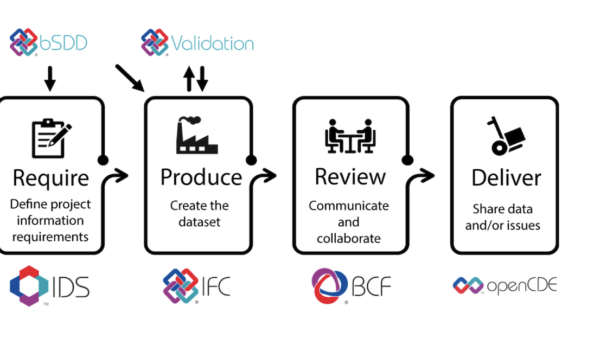What is the openBIM workflow? Does it even really exist? Evandro Alfieri of buildingSmart International clears the confusion.
It seems I’m not the only one getting recurring questions about what the openBIM workflow actually means. Recently, this term has become a hot topic, with more and more people asking us to explain or present it. And I completely get it: new terms and ideas often lead to lots of excitement, but also some confusion.
Therefore it’s time to clarify what an openBIM workflow is. Here’s a little secret: the openBIM workflow doesn’t really exist. At least, not in the way many might think. It’s become a catch-all marketing term that’s resonating well with people eager for clear definitions and solutions. But there’s a bit more nuance to it.
What is openBIM?
To understand this better, let’s start with openBIM itself. At its core, openBIM refers to working with BIM in an open way, leveraging buildingSMART International (bSI) standards and solutions. These standards allow for improved collaboration across different platforms, ensuring data can be exchanged and used seamlessly throughout a project’s lifecycle.
However, openBIM does not refer to a singular tool or method: it’s more of a framework and set of standards (think IFC, BCF, etc) that promote interoperability. It’s about creating an environment where different tools can work together, facilitating an open exchange of information.
On the other hand, a ‘workflow’ is typically defined as an orchestrated sequence of activities or steps that accomplish a particular type of work. It’s how you organise tasks and information flow, often in a repeatable way, to achieve a result.
When we combine these two concepts, an openBIM workflow becomes any process that incorporates bSI standards and solutions. However, it’s critical to understand that there isn’t just one workflow – there are many.
Key clarifications
Here are a few common points that might help clear up confusion:
1. No single, universal workflow
There’s no one-size-fits-all solution when it comes to openBIM workflows. What works for one project might not work for another, depending on the specific needs and tools involved. In short, there’s no magic diagram that can show one perfect openBIM workflow.
2. You don’t need every standard in every workflow
While openBIM workflows involve bSI standards, they don’t have to include them all. Some workflows may use certain standards or solutions, while others use different combinations. The key is that they all promote openness and interoperability.
3. Different projects, different workflows
Many award-winning projects using bSI standards in innovative ways are great examples of openBIM workflows. These projects demonstrate the flexibility and creativity that openBIM allows. Each applies the principles of openBIM differently, depending on project requirements.
4. Specific needs drive specific workflows
Every project or organisation will have a workflow tailored to its needs. This means there is no universal perfect workflow. The only thing that’s one-size-fits-all is ice cream: that’s a solution that works for everyone!
Why this matters
This explanation might shatter the utopian idea of a single, standardised openBIM workflow that covers all use cases. But from what I’ve heard so far, once people let go of that expectation, everything starts to make more sense. Understanding openBIM as a flexible set of processes, rather than a rigid workflow, empowers teams to tailor their approach and get the most out of bSI standards.
By clarifying this for our community, we can avoid confusion and help everyone understand that openBIM is about using the right tools for the right job, not forcing every project into the same mould.
If you have any questions, don’t hesitate to reach out.
Don’t miss out on BIM and digital construction news: sign up to receive the BIMplus newsletter.
The post The openBIM workflow: a practical guide appeared first on BIM+.


